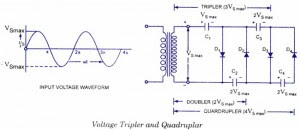
The half-wave voltage doubler, shown in the earlier figure can be extended to provide any multiple of the peak input voltage (that is, 3 Vs max, 4 Vs max or 5 Vs max), as illustrated in the figure shown below. It is obvious from the pattern of the circuit connections how additional diodes and capacitors are to be connected to provide output voltage, 5,6,7 or 8 times the peak input voltage from a supply transformer of rating only Vs max, and each diode in the circuit of PIV rating 2 Vs max. If load is small and the capacitors have little leakage, extremely high dc voltages can be obtained from such a circuit using many sections to step-up the dc voltage.
In operation capacitor C1 is charged through diode Dl to a peak value of transformer secondary voltage, Vs max during first positive half-cycle of the ac input voltage. During the negative half cycle capacitor C2 is charged to twice the peak voltage 2 Vs developed by the sum of voltages across capacitor C1 and the transformer secondary. During the second positive half-cycle, diode D3 conducts and the voltage across capacitor C2 charges the capacitor C3 to the same 2 Vg max peak voltage. During the negative half-cycle diodes D2 and D4 conduct allowing capacitor C3 to charge capacitor C4 to peak voltage 2 VS max. From the fogure shown below it is obvious that the voltage across capacitor C2 is 2 Vs max, across capacitors C1 and C3 it is 3 Vs max and across capacitors C2 and C4 it is 4 Vs max.
If additional diodes (each diode of PIV rating 2 Vs max) and capacitors (each capacitor of voltage rating 2 Vs max) are used, each capacitor will be charged to 2 Vs max. Measuring from the top of the transformer secondary winding (figure below) will give odd multiples of Vg max at the output, while measuring from the bottom of transformer secondary winding will give even multiples of the peak voltage, Vs max.
Some electronic devices, such as cathode ray tubes (in picture tubes in TV receivers, oscilloscopes and computer display) need dc power supply at high voltage with low current. This requirement can be met with either by employing a step-up transformer with a rectifier circuit or by employing voltage multiplier. Since transformers are very bulky and costly, voltage multipliers are preferred. By using voltage multipliers, the voltage level is usually raised well into the hundreds or thousands of volts.
Generally such circuits are employed when both the supply voltage and load are maintained constant.

EmoticonEmoticon